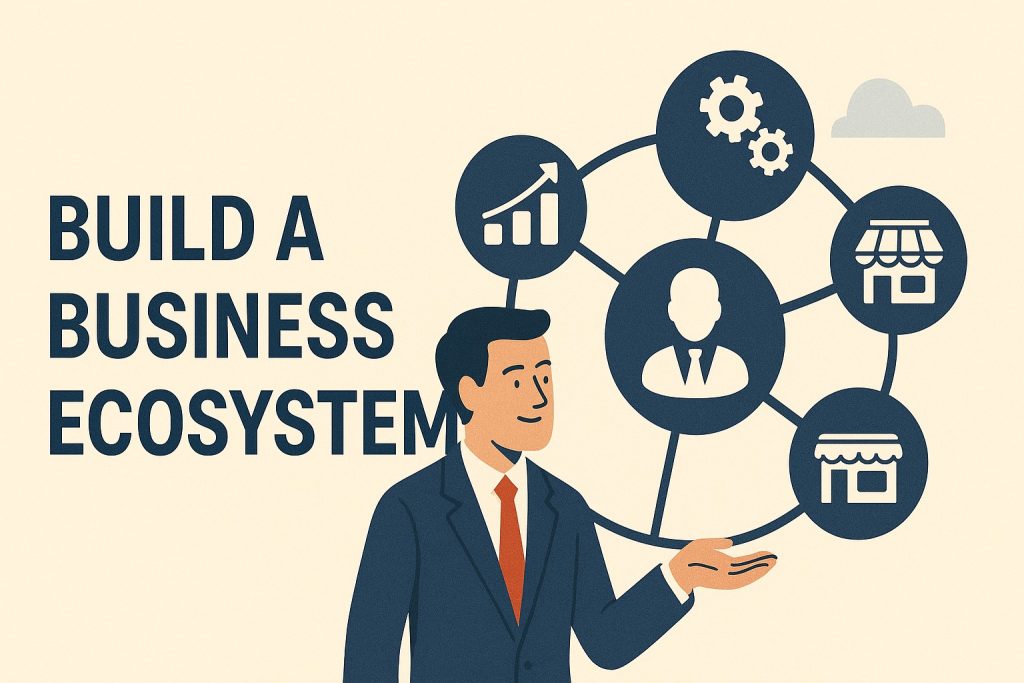Before diving in, it’s crucial to understand your landscape thorough market research sets the stage for building any strong business ecosystem.
What if I told you that your biggest competitor could become one of your most valuable partners? Or that the key to explosive growth isn’t about crushing everyone else, but about collaborating with them? It sounds counterintuitive, but it’s the secret behind some of the world’s most successful companies. They aren’t just building businesses; they’re cultivating powerful business ecosystems.

Forget the old model of a lone company fighting for market share. That’s a slow, expensive, and outdated way to operate. The new playbook is about creating a network of partners, suppliers, and even customers who all work together to create massive value. This isn’t just a theory; it’s a practical framework that can help you accelerate innovation, enter new markets, and build a brand that’s impossible to ignore.
In this guide, I’m going to break down exactly what a business ecosystem is and give you a step-by-step plan to build one. You’ll learn how to find the right partners, leverage technology, and create a system where everyone wins—especially you.
What is a Business Ecosystem, Really?
A business ecosystem is a network of organizations including suppliers, distributors, customers, competitors, and government agencies—that get involved in the delivery of a specific product or service through both competition and cooperation. Think of it like a natural ecosystem. In a rainforest, you have different plants and animals that are all interconnected. They compete for resources, but they also depend on each other for survival.
The same is true in business. Apple doesn’t just sell iPhones. It has built an ecosystem that includes app developers, accessory manufacturers, content creators, and cellular providers. All these players work together to make the iPhone more valuable, which in turn benefits everyone in the network. That’s the power of an ecosystem. It creates a value proposition that is far greater than what any single company could offer on its own.
The Core Players in Any Ecosystem
Every ecosystem has a few key roles. Understanding these roles is the first step to figuring out where you fit in.
- The Orchestrator (or Keystone): This is the central company that provides the platform or foundation for the ecosystem. They set the rules and enable the other players to connect. Google with its Android OS and Amazon with its marketplace are classic orchestrators. They don’t create everything themselves; they create the environment for others to succeed.
- The Partners: These are the companies that build on the orchestrator’s platform. They could be technology providers, content creators, or service providers. In the Salesforce ecosystem, thousands of partners develop apps on the AppExchange to extend the platform’s functionality.
- The Suppliers: These are the traditional providers of goods and services that feed into the ecosystem. For a car manufacturer, this includes everyone from the company that makes the steel to the one that builds the infotainment system.
- The Customers: In an ecosystem model, customers are not just end-users; they are active participants. Their feedback helps improve products, their reviews build social proof, and their engagement creates a community that strengthens the entire network.
Why You Can’t Afford to Ignore the Ecosystem Model
Sticking to a go-it-alone strategy is a surefire way to get left behind. Embracing an ecosystem approach offers tangible benefits that can fundamentally change your growth trajectory. It’s one of the most powerful business growth strategies available today.
1. Drive Unstoppable Innovation
You don’t have all the best ideas. No one does. By collaborating with a diverse network of partners, you expose your business to new perspectives, technologies, and skills. This cross-pollination is a breeding ground for innovation. When you hit a roadblock, you can tap into the collective brainpower of your ecosystem to find solutions you would have never thought of on your own.
2. Expand Your Market Reach Overnight
Want to enter a new market? Instead of spending years and millions of dollars building a presence from scratch, you can partner with a company that’s already there. A strategic partnership gives you instant access to their customer base, distribution channels, and local market knowledge. This is a core component of effective market development, allowing you to scale your reach efficiently.
3. Build a Moat Around Your Business
When your product is part of an integrated ecosystem, it becomes much harder for customers to leave. Think about it: once you’re invested in Apple’s ecosystem—with your iPhone, MacBook, and Apple Watch all syncing seamlessly—the thought of switching to an Android phone becomes a huge hassle. This “stickiness” creates a powerful competitive advantage and boosts customer lifetime value. It helps you turn a small business into a scalable brand that retains customers for the long haul.
4. Increase Efficiency and Focus on Your Strengths
You can’t be the best at everything. By leveraging partners for non-core activities, you can focus your resources on what you do best. A tech startup doesn’t need to build its own server farms; it can use Amazon Web Services. This allows you to operate a leaner business, reduce costs, and pour your energy into your unique value proposition.
How to Build Your Own Business Ecosystem (A 5-Step Guide)
Ready to start building? Here is a practical, step-by-step guide to creating and nurturing a thriving business ecosystem.
Step 1: Map Your Current Position
You’re already part of an ecosystem, even if you don’t realize it. The first step is to understand what that looks like.
- List Your Connections: Grab a whiteboard and map out every entity your business interacts with. This includes your suppliers, key customers, technology vendors, marketing agencies, and even your competitors.
- Analyze the Value Exchange: For each connection, define what you give and what you get. Is it purely transactional (you pay them, they deliver a service), or is there a deeper level of collaboration?
- Identify Gaps and Opportunities: Where are your dependencies? Are you relying too heavily on one supplier? Are there companies serving the same customer base that you could be partnering with? This map will reveal the weak points and hidden opportunities in your current network.
Step 2: Define Your Role and Core Value
You don’t have to be the next Apple or Google to succeed in an ecosystem. You just need to be clear about the value you provide.
- Find Your Superpower: What is the one thing your business does better than anyone else? This is your core competency and the foundation of your value contribution.
- Choose Your Role: Based on your superpower, decide on your role. Do you have what it takes to be an orchestrator, building a platform for others? Or are you better suited as a niche player, providing a critical component or specialized service? Being the best in a specific niche can be just as profitable as being the orchestrator. This focus is critical to achieving your long-term brand goals.
Step 3: Actively Seek and Nurture Strategic Partnerships
Partnerships are the engine of a business ecosystem. This is about moving beyond simple vendor relationships to build true alliances. A strategic partnership is built on shared goals and mutual trust.
- Look for Win-Win Scenarios: When you approach a potential partner, don’t just talk about what you want. Frame it in terms of what they will gain. How can you help them reach new customers, improve their product, or increase their revenue?
- Start Small, Prove the Value: Don’t try to boil the ocean. Start with a small, well-defined joint project. This allows you to test the waters and build trust before committing to a larger-scale collaboration.
- Formalize the Relationship: While trust is essential, clear agreements are what make partnerships last. Define roles, responsibilities, communication protocols, and how you’ll measure success.
Example: The partnership between Spotify and Uber. By integrating Spotify into the Uber app, riders got to be the DJ for their trip. This improved the Uber experience and gave Spotify access to a captive audience. It was a simple, brilliant collaboration that benefited both companies and their customers.
Step 4: Leverage Data and Business Intelligence
In a modern ecosystem, data is the glue that holds everything together. The ability to collect, analyze, and act on data from across your network is what separates the winners from the losers.
- Share Insights, Not Just Data: Don’t just dump raw data on your partners. Use analytics to turn that data into actionable insights. For example, a retailer can share sales trend information with its suppliers to help them optimize production and inventory.
- Personalize the Customer Experience: Use data to create a seamless and personalized experience for your customers. A hotel that partners with local restaurants and tour operators can use booking information to offer tailored recommendations and packages.
- Monitor Ecosystem Health: You need to track the performance of your ecosystem. Keeping up with business intelligence industry trends will allow you to implement dashboards that monitor key metrics like partner engagement, co-created revenue, and customer satisfaction with integrated solutions.
Step 5: Foster a Community, Not Just a Network
The strongest ecosystems are built on a sense of community. It’s about creating a culture where partners feel like they are part of something bigger.
- Communicate, Communicate, Communicate: Keep your partners in the loop. Use regular newsletters, dedicated forums, and partner summits to share updates, gather feedback, and celebrate wins.
- Encourage Partner-to-Partner Collaboration: Create opportunities for your partners to connect with each other. This builds a more resilient and decentralized network where innovation can happen organically.
- Celebrate Shared Success: When the ecosystem hits a milestone, make a big deal out of it. Publicly recognize the contributions of your partners. This reinforces the idea that you are all on the same team, working towards a common goal.
The Future is Collaborative
The shift from a standalone company to a connected member of a business ecosystem is not just a trend, it’s the future of business. It requires a fundamental change in mindset, from one of scarcity and competition to one of abundance and collaboration.
Building a thriving ecosystem is a marathon, not a sprint. It takes time, patience, and a genuine commitment to creating shared value. But the payoff is enormous. Businesses that master the ecosystem model will be more innovative, more resilient, and better positioned for long-term, sustainable growth.
So, where do you start?
Go back to Step 1. Map out your current network and find one potential partner you can reach out to this week. Your journey to building a powerful business ecosystem begins with that single connection.


